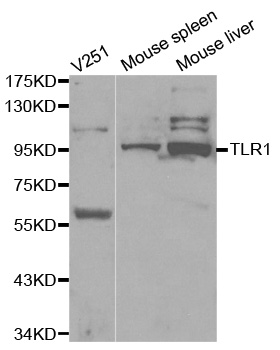TLR1 Rabbit Polyclonal Antibody
Frequently bought together (1)
Other products for "TLR1"
Specifications
| Product Data | |
| Applications | ICC/IF, IHC, WB |
| Recommended Dilution | WB 1:500 - 1:2000;IHC 1:50- 1:200;IF 1:50- 1:200 |
| Reactivities | Human, Mouse, Rat |
| Host | Rabbit |
| Isotype | IgG |
| Clonality | Polyclonal |
| Immunogen | Recombinant protein of human TLR1 |
| Formulation | Store at -20°C (regular) and -80°C (long term). Avoid freeze / thaw cycles. Buffer: PBS with 0.02% sodium azide, 50% glycerol, pH7.3. |
| Concentration | lot specific |
| Purification | Affinity purification |
| Conjugation | Unconjugated |
| Storage | Store at -20°C as received. |
| Stability | Stable for 12 months from date of receipt. |
| Predicted Protein Size | 786 |
| Gene Name | toll like receptor 1 |
| Database Link | |
| Background | Members of the Toll-like receptor (TLR) family, named for the closely related Toll receptor in Drosophila, play a pivotal role in innate immune responses (1-3). TLRs recognize conserved motifs found in various pathogens and mediate defense responses. Triggering of the TLR pathway leads to the activation of NF-κB and subsequent regulation of immune and inflammatory genes. The TLRs and members of the IL-1 receptor family share a conserved stretch of approximately 200 amino acids known as the TIR domain. Upon activation, TLRs associate with a number of cytoplasmic adaptor proteins containing TIR domains including MyD88 (myeloid differentiation factor), MAL/TIRAP (MyD88-adaptor-like/TIR-associated protein), TRIF (Toll-receptor-associated activator of interferon), and TRAM (Toll-receptor-associated molecule). This association leads to the recruitment and activation of IRAK1 and IRAK4, which form a complex with TRAF6 to activate TAK1 and IKK. Activation of IKK leads to the degradation of IκB that normally maintains NF-κB inactivity by sequestering it in the cytoplasm. Toll-like receptor expression is highest in peripheral blood leukocytes, monocytes, macrophages, though TLR1 expression may be less restricted than other family members (4,5). TLR1 associates with TLR2 to cooperatively mediate immune responses to bacterial lipoproteins and lead to NF-κB activation (6,7). TLR1 shows highest homology to TLR6, which shares 69% sequence identity (8). |
| Synonyms | CD281; rsc786; TIL; TIL. LPRS5 |
| Reference Data | |
| Protein Families | Druggable Genome, Transmembrane |
| Protein Pathways | Toll-like receptor signaling pathway |
Documents
| Product Manuals |
| FAQs |
| SDS |
{0} Product Review(s)
0 Product Review(s)
Submit review
Be the first one to submit a review
Product Citations
*Delivery time may vary from web posted schedule. Occasional delays may occur due to unforeseen
complexities in the preparation of your product. International customers may expect an additional 1-2 weeks
in shipping.






























































































































































































































































 Germany
Germany
 Japan
Japan
 United Kingdom
United Kingdom
 China
China





